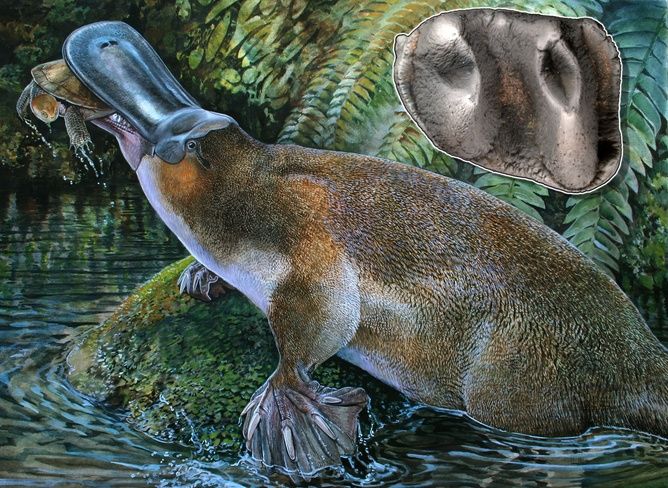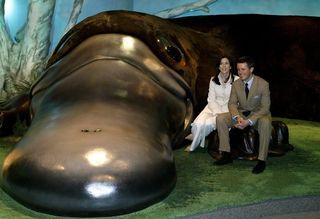
Fossil of Giant Platypus Unearthed in Riversleigh (Op-Ed)

This article was originally published at The Conversation. The publication contributed the article to LiveScience's Expert Voices: Op-Ed & Insights.
A new study by Rebecca Pian, Mike Archer and Sue Hand, published today in the Journal of Vertebrate Paleontology, describes the tooth of a new, giant species of extinct platypus.
The fossil history of the platypus shows the modern platypus is just the tip of the iceberg of a diverse radiation.
A toothier platypus
In 1975, American palaeontologists Michael Woodbourne and Richard Tedford published a description of ancient platypus teeth from the Etadunna and Namba formations in central Australia. The specimens were dated from the Oligocene, 24 to 26 million years ago.
They described these teeth as belonging to an ancient platypus they named Obdurodon insignis. The name Obdurodon comes from the Greek for “lasting (obdurate) tooth”. It was coined to distinguish extinct toothed platypuses from the essentially toothless modern species - modern adult platypus do not have teeth, but juveniles do.
Later on, a spectacular skull of another ancient platypus was recovered from the limestone deposits of the Riversleigh World Heritage Area of northwestern Queensland. The skull, named Obdurodon dicksoni, was near complete with teeth. It was estimated to be from the mid-Miocene, around 15 million years ago.
A surprising discovery was published in 1992, where the teeth of a South American platypus, Monotrematum sudamericanum, were found in Patagonia, Argentina. They were dated at 61 million years old, demonstrating the platypus had a much wider range in times past.
Sign up for the Live Science daily newsletter now
Get the world’s most fascinating discoveries delivered straight to your inbox.

A big platypus with a broad diet
What is spectacular about the new discovery, named Obdurodon tharalkooschild, is its size. It is the largest species of platypus ever described; the authors estimate it was almost a metre long. Compare this to the modern platypus, where a large male from Tasmania is lucky to reach 60cm. This species was double the size of the typical mainland platypus.
Like the skull of Obdurodon dicksoni, this skull was recovered from the limestone formations of the Riversleigh World Heritage Site, where Archer and his colleagues have been working for over 20 years. The well-preserved fossils from this area have already rewritten the book on marsupial evolution, and now they are doing the same for Australia’s egg-laying mammals (monotremes). The Two Tree site, where the tooth was found, is not actually dated, but the authors estimate the age at between 15 and 5 million years old.
So what information can we gather about the life of this giant platypus? Basing the whole picture on one tooth makes it difficult, but the bumps and ridges indicate that it may have fed on wide range of aquatic organisms. It would have eaten crayfish and other freshwater crustaceans, like the modern platypus does, but its large size and robust dentition would have let it feed also on small vertebrates including the lungfish, frogs, and small turtles that are preserved with it.
Named for a legend
The species name, tharalkooschild, is in reference to an Indigenous Australian creation story about the origin of the platypus.
During the Dreaming, Tharalkoo was a head-strong duck inclined to disobey her parents. Her parents warned her not to swim downriver because Bigoon the Water-rat would have his wicked way with her. Scoffing, she disobeyed her parents and was raped by Bigoon.
By the time Tharalkoo escaped and returned to her family, the other girl ducks were laying eggs, so she did the same. But instead of a fluffy little duckling emerging from her egg, her child was an amazing chimera that had the bill, webbed hind feet, and egg-laying habit of a duck, along with the fur and front feet of a rat. It was the first platypus.
Changing environment, changing platypus
The discovery of this fossil further adds to our understanding of the evolution of Australia’s fauna, and the environmental changes to the continent.
It further enriches Australia’s heritage, but it may also have a valuable message for the future of Australia’s fauna. The platypus had a higher diversity of form and much wider range in times past.
Its reduction to one species living on the east coast of Australia is certainly due to climate and resulting environmental changes. As the Australian continent moved north over millions of years, the previously wet interior of the continent dried up. This meant that the platypus became restricted to the wet east coast of the continent.
With a rapidly changing climate, we may need to have further concern for one of the world’s most unique animals. Most climate predications have the east coast of Australia becoming hotter and drier, with more extreme weather events. With human impact on waterways increasing on the east coast, the last member of the ancient, and once more diverse, platypus family could be in danger in the future.
Mathew Crowther receives funding from Australia Pacific Research Foundation.
This article was originally published at The Conversation. Read the original article. The views expressed are those of the author and do not necessarily reflect the views of the publisher. This version of the article was originally published on LiveScience.












